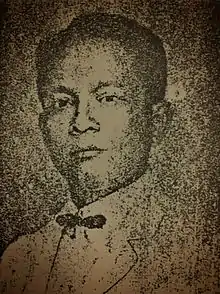Marcial Calleja
Marcial Calleja y Casitas (1863 – 1914) was a Filipino lawyer who was elected as one of the representatives of Albay to the Malolos Congress. He was also elected assemblyman for the first district of Albay in the Second Philippine Assembly.

Marcial Calleja | |
|---|---|
| Member of the Philippine Assembly for the 1st district of Albay | |
| In office 1909–1912 | |
| Member of the Malolos Congress from Albay | |
| In office 1898–1899 | |
| Personal details | |
| Born | Martial Calleja y Casitas August 22, 1863 Malinao, Albay, Spanish East Indies |
| Died | May 5, 1914 (aged 50) Manila, Philippine Islands |
Early life and education
Calleja was born on 22 August 1863 in Malinao, Albay, to Juan Calleja and Silvestre Casitas. He was the oldest of three children.
He studied in the Seminary of Nueva Caceres for his segunda enseñanza (secondary education), and later on took a course in philosophy from the same institution. Then, he enrolled in the University of Santo Tomas where he received a title in agronomy in 1885. He was already starting his career when he returned to study law in the same university, graduating with a degree of Bachelor of Laws in 1894.
Career
Soon after receiving his title in surveying, Calleja was appointed perito tasador del estado (state assessor) and was assigned in Laguna until 1891, when he was chosen as secretario de ayuntamiento (city council secretary) through a competitive test. He was first assigned in Albay and, later on, in Batangas (1889). In 1894 – 1895, he was the secretary of the Junta Central (central board) of the Albay delegation to the Exposición Regional de Filipinas that was held in Manila in 1895.
In 1898, under the revolutionary government, he became the city council secretary of Albay. In September of the same year, he became the consejero de justicia, juez instructor (instructional judge) and Asesor de Guerra (military adviser) of the Junta Revolucionaria for the province of Albay.[1]
In the morning of 22 December 1898, after the local leaders of Albay took their oath of office before President Emilio Aguinaldo, Calleja, together with Salvador Vivencio del Rosario,[2] was elected as a representative to the Malolos Congress and signatory to Malolos constitution.[3]
He was captured during the Filipino-American War in July 1900. After his release, he joined the Federal Party and was appointed as provincial fiscal of Albay on 13 May 1901 (until 1905). In 1904, he was part of the honorary board of Filipino commissioners[4][5] who took part in the Louisiana Purchase Exposition under Dr. Trinidad Pardo de Tavera. Calleja received a gold medal of honour during the said exposition.[6][7]
The following year, on 1 April 1905, he was appointed assistant attorney in the Attorney General’s office, a position which he held until he resigned on 21 December 1908.
In 1909, Calleja was back in Albay conducting review classes for students taking the bar examinations. In the same year, he was elected assemblyman of the first district of Albay in the Second Philippine Assembly, where he participated in the passage of many significant municipal and provincial codes.
Shortly thereafter, however, he was stricken with paralysis, which restricted him to serve long in the Assembly.
Personal life
Calleja was married to Teresa Asenjo of Albay with whom he had eight children. One of his children, Ambrosio A. Calleja, became a lawyer and a member of the Constitutional Convention of 1934 to 1935. He suffered from his paralysis for four years until his death on 5 May 1914. His remains were buried at La Loma Cemetery in Manila.
Marcial Calleja became part of the Universidad de Santo Tomàs hall of fame (August 26, 1979).
References
- Nota Necrologica.
- "TOMAS L". geocitiessites.com. Retrieved 2016-03-20.
- "Philippine History -- The Malolos Congress: Signatories of the Malolos Constitution". msc.edu.ph. Retrieved 2016-03-20.
- "Full text of "Brief biography of the members of the Honorary Board of Filipino Commissioners to the Louisiana Purchase Exposition .."". archive.org. Retrieved 2016-03-20.
- "Indianapolis Journal 26 May 1904".
- "p.172-3. Report of the Philippine Exposition Board to the Louisiana Purchase Exposition: And Official List of Awards Granted By the Philippine International Jury at the Philippine Government Exposition World's Fair, St. Louis, Mo". www.forgottenbooks.com. Retrieved 2016-03-20.
- "Report of the Philippine Exposition Board, Louisiana Purchase Exposition, Official List of Awards, St. Louis, Mo., 1904".
- U.P profesor Manuel, E. Arsenio (1955). Dictionary of Philippine Biography, Volume 1 pp. 105 – 106 (Edition 1957) . Quezon City: Filipiniana Publications.
- “Lucha Y Libertad.” Ang Aming Angkan. (Accessed on 2 November 2009).
- “Marcial A. Calleja (1863 – 1914) Delegate to the Malolos Congress.”
- "Directorio Biografico Filipino" by P. Reyes y Cia, Editores pp. 15 – 16 (Edition 1908)
- "Eminent Filipinos" by Hector K Villaroel, pp78